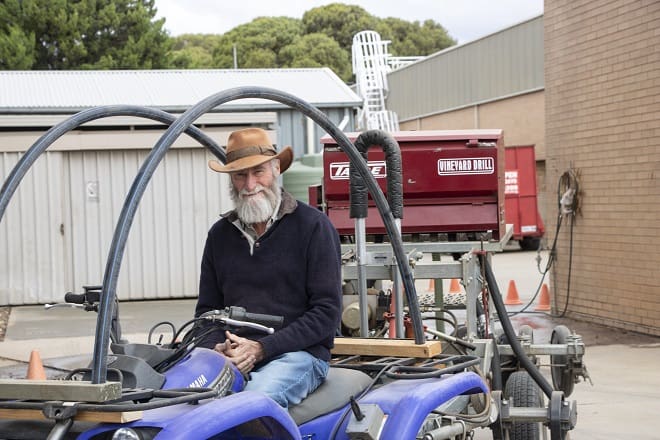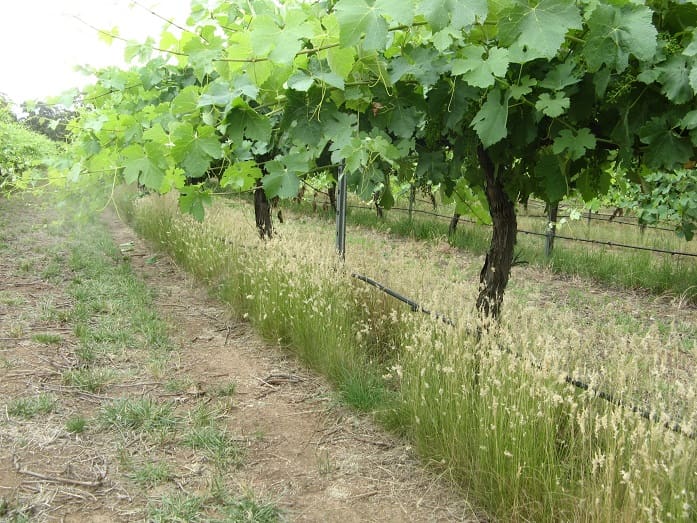
University of Adelaide Roseworthy Campus research agronomist, Chris Penfold, says effective living mulches can provide a long-term management solution to stop fencelines being a source of herbicide resistant weeds.
KEEPING weed numbers down in crops is a high priority on most farms, yet herbicide resistance can quietly increase along fencelines and around infrastructure.
Having a ‘set and forget’ weed control option for these areas could save money and arrest the evolution of herbicide resistance in weeds.
In vineyards the under-vine area is often kept bare using a limited number of suitable herbicides, opening the door to herbicide resistance.
Populations of glyphosate-resistant annual ryegrass and fleabane have been confirmed in Australian vineyards and along fencelines and roadways.
Having worked previously in broadacre cropping, and more recently in the wine industry, research agronomist Chris Penfold, University of Adelaide is interested in identifying alternative ways to manage under-vine and mid-row areas in vineyards, which also has implications for fencelines on grain and mixed farming properties.
“In many cases it might be better to replace weeds on the fencelines with a competitive but palatable option,” he said.
“In vineyards, the continual use of herbicides and cultivation for weed control under the vines has a long-term detrimental effect on soil health and grape quality. Consequently, our research aimed to identify cover crop species that would build soil health and conserve soil moisture for the vines. Since this is not a priority on grain farms, a range of other options might be chosen but the principle can remain – establish permanent cover and stop fenceline spraying,” Mr Penfold said.
Of the treatments Mr Penfold included in his trial, Kasbah cocksfoot and wallaby grass stood out as competitive species that did not spread into neighbouring areas and could be suitable for controlling weeds on fencelines.
“Kasbah provided good suppression of fleabane and thistles in vineyards, especially in irrigation areas. It is a summer dormant perennial that doesn’t recruit, even in vineyards. It did suppress vine growth so it isn’t a great option for vineyards but could work for fencelines,” Mr Penfold said.
“The other competitive border species we tried was wallaby grass, a native perennial, which provided good cover, but seed is expensive and it can be hard to establish. By not applying herbicide to fencelines growers will save money, which can be partly re-directed to the establishment of effective living mulches to provide a long-term management solution to stop fencelines being a source of herbicide resistant weeds.”

Native perennials, such as wallaby grass, can provide good cover along the borders without spreading into the crop.
Perennial species and self-regenerating annuals are the preferred options to minimise on-going management costs.
The best species to establish will vary markedly between regions with prostrate saltbush having potential in drier areas, and lucerne and wallaby grass providing good control, even against caltrop, in other situations.
In the vineyard situation a medic plus annual ryegrass cover provided good winter weed control and soil health benefits. By not spraying the annual ryegrass herbicide resistance does not evolve.
Another option Mr Penfold has investigated is in-crop grazing with sheep. With living mulches growing around the borders, sheep can be allowed to graze in established crops such as chickpea, faba bean, fenugreek and lupins, at light stocking density.
The sheep will preferentially graze the in-crop weeds and may also assist with weed control along controlled traffic wheeltracks, especially if weed seed is directed onto the wheeltracks using a chaff-deck for harvest weed seed control.
“Sheep are selective grazers and lambs are more selective than older sheep,” he said.
“Different sheep breeds also graze differently so these things need to be considered for each farming system. The principle to apply is to incorporate non-chemical management practices where possible into the farming system, which should then extend the useful life of herbicides.”
Where pastures are part of the crop rotation it can be as simple as establishing the pasture species along the fencelines and leaving them in place when the paddock rotates into the cropping phase.
Similarly, the crop can be sown right up to the fenceline and either mown or baled for hay prior to harvest.
Nipping herbicide resistance in the bud in non-cropping areas is an important strategy often overlooked.
These areas are often sprayed when weeds are large, often using the same herbicide (usually glyphosate) each time, and there is rarely any follow-up treatment of survivors. This is a recipe for rapid evolution of herbicide resistance.
Source: WeedSmart, www.weedsmart.org.au

HAVE YOUR SAY